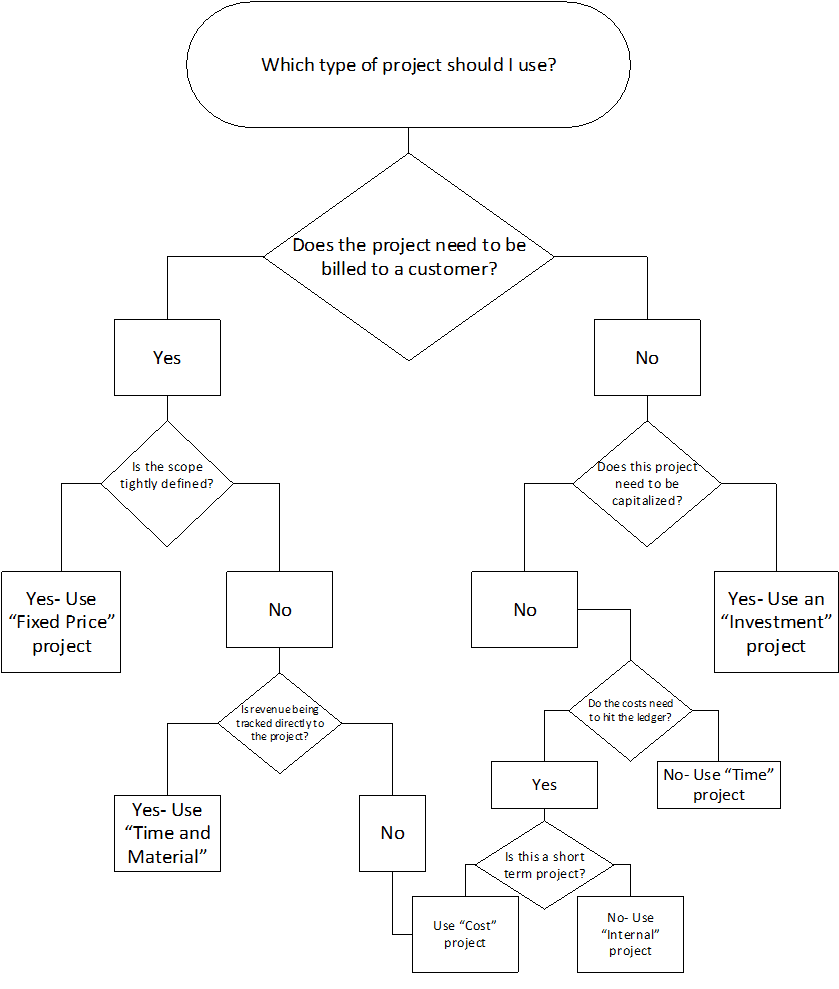
|
|
#1 |
|
Участник
|
powerobjects: Dynamics 365 for Finance and Operations Project Types
Источник: https://www.powerobjects.com/2018/04...project-types/
==============  There are six types of projects that can be utilized in Dynamics 365 for Finance and Operations: Time and Material, Fixed Price, Cost, Investment, Internal, and Time. Many of these projects sound similar, so let’s explore when to use each project type. Time and Material The first and the most common type of project available is Time and Material. These projects are used to bill an external customer. All time, costs, expenses, items, and fees are booked against a project, then billed directly back to the customer. Time and Material projects are generally used for larger projects when a scope isn’t firmly defined. Time and Material also allows for greater flexibility of billing timing. Examples of a typical Time and Material project includes professional services and construction projects. Fixed Price Another type of project commonly used is Fixed Price. Fixed Price projects usually have a tightly defined scope. The scope will include frequency of invoicing, amount of invoices, budget, precisely what work will be completed, and how many resources will be utilized. If the scope of these projects change, generally a change order will be created – this would be another Fixed Price project that will likely designated as a sub-project. Sub-projects are projects that can be billed separately from the parent project, but will still be linked to it. When this link exists, you can report against the costs and revenues for the parent and all sub-projects together, or individually. Like a Time and Material project, all time, costs, expenses, items, and fees are booked against the project, but only a fixed amount is billed to a customer. Revenue is booked to a WIP account to aide in determining the percent complete on a project. Fixed Price projects are commonly used for government projects, or any other project that has a tightly defined statement of work where the costs are already known. Cost Cost projects can either be internal (non-billable) or external (billable) projects. Typically, they are a short-term internal project that is used for tracking hours, expenses, and item costs. Cost projects cannot be capitalized. This would be an external project if items are sold to a specific customer from this project. These items can either already be in inventory or will trigger the production of the items. It will be an internal project if costs and items need to be tracked to a project that are not immediately purchased by a customer. The items will be purchased later, resulting in revenue. This revenue can be tracked back to the project, if desired, through financial dimensions. Project invoices are never created for Cost projects. An example of a Cost project would be creating a video game that will be available for purchase. Investment Investment projects are used for internal projects that need to be capitalized. Only items, hours, and expenses are tracked against Investment projects in Dynamics 365 for Finance and Operations. These projects will not be billed to a customer for reimbursement, they are for tracking costs only. An example of an investment project would be repairs to an office building where you are increasing the value of an asset that is capitalized. Internal Internal is another type of project that is not billed to a customer. This type of project tracks all costs related to a project, but reimbursement cannot be sought. This is a good project to use if you are developing something internally, like a webinar, that you plan to make available to multiple customers. You do not want to track the cost of the developing of the webinar for every customer, so you create an internal project and track hours and expenses back to the internal project. After the project is completed and a customer purchases the webinar the sales order will be linked to the project via financial dimensions. This strategy allows you to track total revenue and total costs to a project to determine if your webinar is profitable, but you are not billing a customer for the development. Internal projects and Cost projects are similar when used for internal purposes. Time A Time project is the third type of internal project offered in Dynamics 365 for Finance and Operations. This type of project is used to only track time and it does not have any costs hitting the ledger. This project type would be used to track workers that are NOT working on a billable project, but their time needs to continue to be tracked. For example, if an employee is taking vacation or sick time and their time needs to be tracked for employee utilization, but they are not working on a billable project. Their utilization needs to be tracked and this is used for resourcing other projects. When employees are booking time to this non-billable project, they appear as utilized so they will not be overbooked on other projects. Hopefully this blog helps you determine when to use each project type in Dynamics 365 for Finance and Operations! See the diagram below for an additional flow chart to help you determine project type.  For more Dynamics 365 for Finance and Operations tips and tricks – be sure to subscribe to our blog! Happy Dynamics 365’ing! Источник: https://www.powerobjects.com/2018/04...project-types/
__________________
Расскажите о новых и интересных блогах по Microsoft Dynamics, напишите личное сообщение администратору. |
|
|
|
|
|